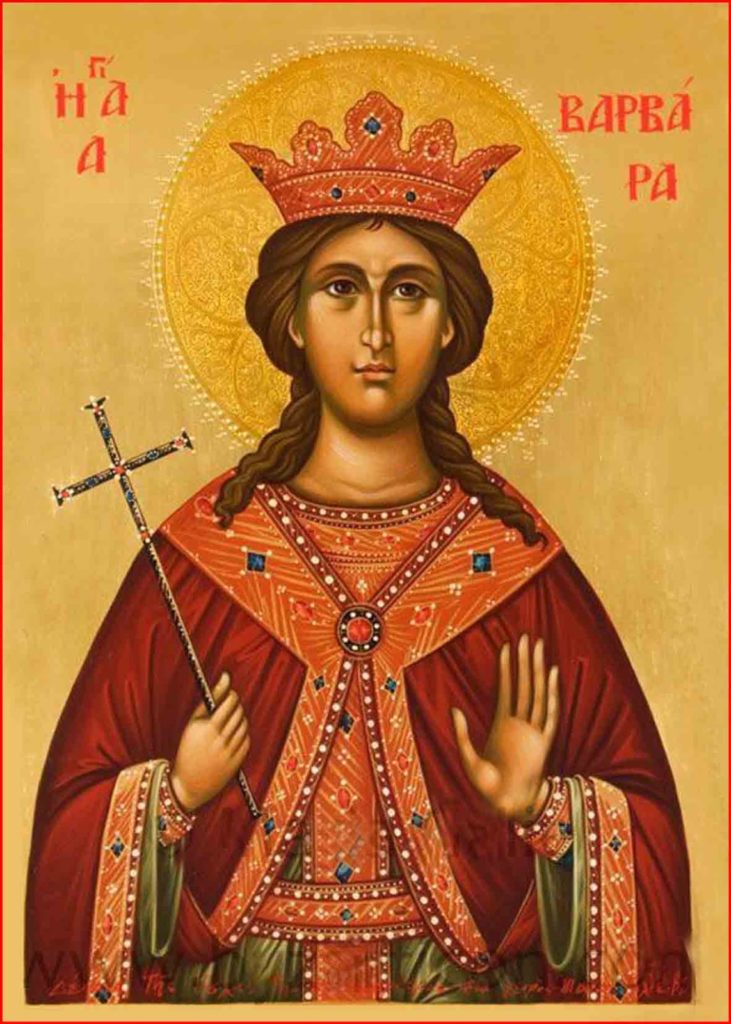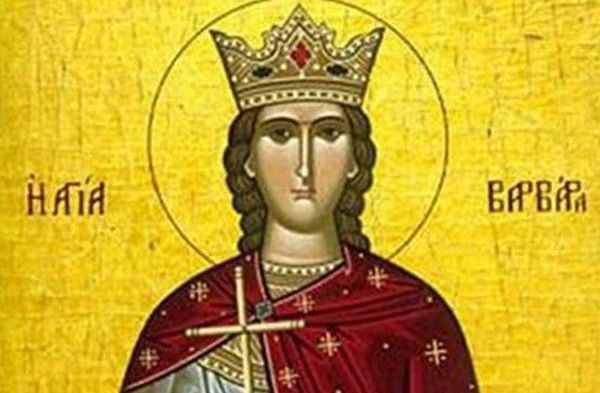On December 4, the Greek Orthodox Church commemorates Agia Barabara the Great Martyr, who is considered one of the major Saints of the Greek Orthodox Church.

Venerated as one of the 14 Auxiliary Saints (Holy Helpers), she is invoked in thunderstorms and is the Patron Saint of firemen, artillerymen, miners and those engaged in hazardous occupations. Agia Barbara is also the Patron Saint of Drama and Thrace in Macedonia.
This great Saint was from Heliopolis of Phoenicia and lived during the reign of Maximian.
She was the daughter of a certain idolater named Dioscorus. He was a wealthy man who was originally from the nearby village of Galassos. He had only one child, a very beautiful girl named Barbara. Her parents were extremely proud of her, not only because of her beauty but of her virtuosity as well.
To protect her, her parents erected a fortress where they placed Barbara while still young, as with Saint Christina. They supplied her with all her needs: servants, food and clothing. When Barbara came of age, many military officers of Heliopolis asked her father for her hand in marriage, for they had heard of her great beauty and charm. He refused, however, to give his promise to anyone until he conferred with his daughter.
Barbara responded by telling her father that if he forced her to marry, she would commit suicide. Dioscuros left the fortress believing that, in time, he could convince her to consent to marriage.

When Barbara came of age, she was enlightened in her pure heart and secretly believed in the Holy Trinity. About this time, Dioscorus began building a bath-house; before it was finished, he was required to go away to attend to certain matters, and in his absence, Barbara directed the workmen to build a third window in addition to the two her Father had commanded.
She also inscribed the sign of the Cross with her finger upon the marble of the bathhouse, leaving the saving sign cut as deeply into the marble as if it had been done with an iron tool. When the Synaxarion of Saint Barbara was written, the marble of the bathhouse and the cross inscribed by Saint Barbara were still preserved, and many healings were worked there.
When Dioscorus returned, he asked why the third window had been added; Barbara began to declare the mystery of the Trinity to him. Because she refused to renounce her faith, Dioscorus tortured Barbara inhumanely.
These words angered her father and made him forget that Barbara was his daughter. Drawing his sword and threatening to kill her, Barbara fled to a nearby mountain. Reaching the top, she raised her arms and prayed to God for help. The earth parted and swallowed most of her body. In the meantime, her father asked two shepherds whether they had seen his daughter. The first told him that he hadn’t so that she might be spared. However, the other pointed in the Saint’s direction.
Finding his daughter, Dioscuros forced her back to the fortress and locked her up. He then went to the city's ruler, Marcius and informed him that Barbara was a Christian. She was then given to Marcius with her father’s damnation. Marcius had the Saint stripped and beaten with sticks, then her wounds rubbed with vinegar. She was then imprisoned. Towards midnight, a bright light appeared to Barbara, and a voice told her not to fear, Christ was always with her. As soon as the words were spoken, all her wounds disappeared. A God-fearing woman named Julia, who was imprisoned with Barbara, saw the miracle. She praised God with all her heart and decided to martyr for her Christian beliefs.
The torture continued for Barbara. The ruler ordered his soldiers to tear the Saint’s body with iron claws, burn her with torches and hit her head with a spiked club.
Julia, witnessing the torture, felt so much sorrow that she began to cry uncontrollably. Discovering that she was also a Christian, Marcius ordered that she be hung beside the Saint to suffer the same tortures. He then had his soldiers cut off the martyr’s breasts and taken back to prison.
St. Barbara was stripped of her clothing to be marched throughout the city. Seeing that he could not overcome the Saint with threats and torture, Marcius ordered his soldiers to behead both Barbara and Julia.

Present at all these tortures was Dioscuros, Barbara’s father. He felt neither pain nor remorse for what he had done to his only child. When the ruler sentenced them to death, Dioscuros requested that he be permitted to perform the execution of his daughter. Barbara and Julia were taken to the mountain where Dioscuros had previously captured his daughter. He beheaded St. Barbara and a soldier beheaded St. Julia. For several seconds the earth shook. The earth then opened and swallowed the bodies of the two martyrs.
God was quick with Divine Retribution to Dioscuros, for a thunderstorm arose as he descended the mountain. A bolt of lightning descended from the heavens and killed this bloodthirsty tyrant. The second bolt of lightning immediately descended and murdered St. Julia’s executioner.
When Marcius heard of the events which occurred at the execution, he became psychologically distressed and soon afterwards died of his remorse.
After several days, a pious Christian named Valentios saw in his dream two white-robed virgins who instructed him to go to the mountain on which the Saints had been executed and to dig to find their bodies. Valentios immediately arose from his bed and went to the mountain with several other Christians to follow the Saint’s instructions. After digging for several hours, they found the holy bodies of Saints Barbara and Julia. With great respect and reverence, they venerated the bodies of the Saints. The holy bodies of the martyrs were taken to the village of Galassos, where they were entombed with honour.
In the sixth century, the relics of the holy Great Martyr Barbara were transferred to Constantinople. Six hundred years later, they were transferred to Kiev (July 11) by Barbara, the daughter of the Byzantine Emperor Alexius Comnenos, who married the Russian prince Michael Izyaslavich. They still rest at Kiev’s St Vladimir cathedral, where an Akathist to the saint is served each Tuesday.
Happy Name Day to everyone celebrating today.
Barbara, Barbaro, Barbaroula, Roula, Barbaritsa, Ritsa, Serafeim, Serafeimia, Serafeim, Damascus, Demaskinos, Demaskini, Demascene
Χρόνια Πολλά σε όλους και όλες που γιορτάζουν σήμερα. Σας ευχόμαστε αγάπη, ευτυχία και υγεία πάνω απ'όλα!
Βαρβάρα, Βαρβάρω, Βαρβαρούλα, Ρούλα, Βαρβαρίτσα, Ρίτσα, Σεραφείμ, Σεραφειμία, Σεραφειμή, Δαμασκηνός, Δαμασκηνή
Xronia Polla!
